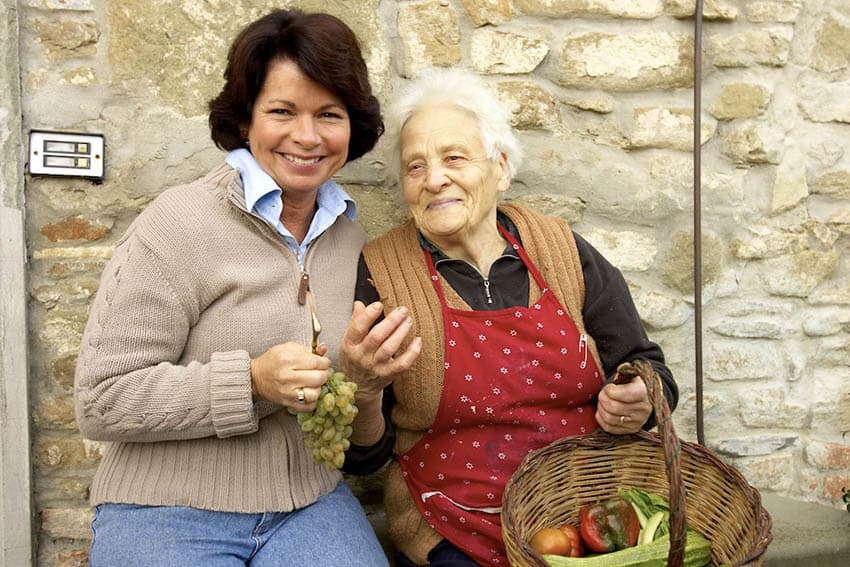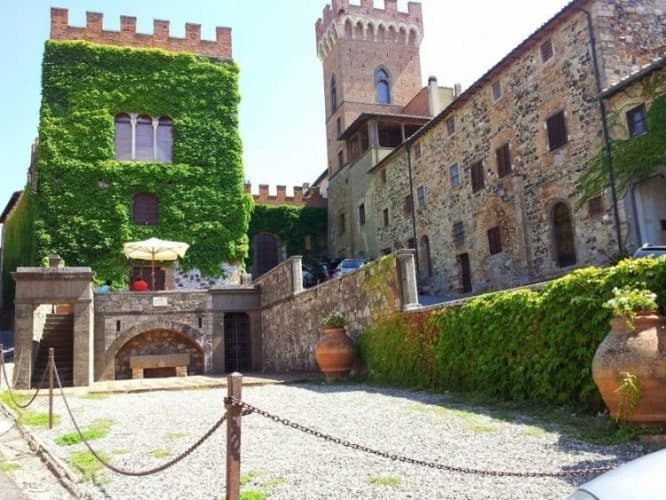
Lost in transit in on the way to a Castello in Tuscany
By Gaby Koppel
The road ahead twisted and turned in our headlights then straightened out and at last, it began to look as if we might be nearing our destination.
But just at that moment the way ahead veered steeply uphill again. There were no road signs, the only light the distant twinkle of hilltop villages.
“We must have taken a wrong turn,” I said. “It’s been twenty minutes since we left the main road and there’s still no sign of any Castello.” It had been daylight as we left Pisa, and a journey ‘less than an hour’ south had stretched out through sunset and dusk until the air outside was black as a priest’s cassock.
The words ‘when will we be there?’ hung in the stale air between us and a trio of exhausted, hungry teens as our two-car convoy crept apprehensively through the lesser-known reaches of the Tuscan countryside.
Suddenly the great adventure of abandoning the package tourist trail didn’t seem quite so attractive. Oh for a jolly tour guide waving a flag in the air, or an English pub serving fish and chips!
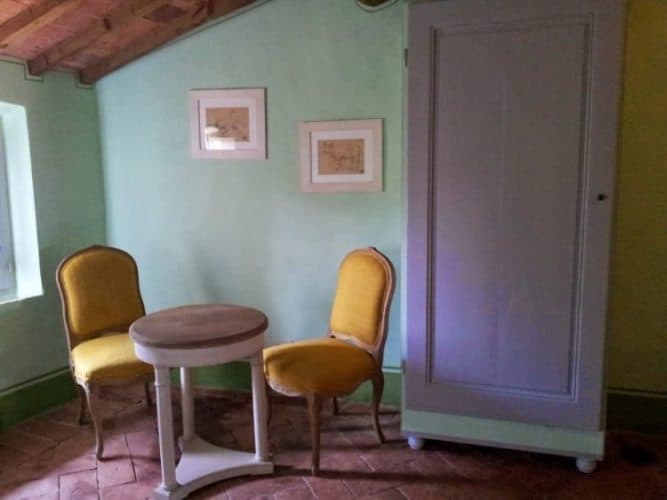
And then suddenly a left-turn beckoned, the road flattened out under street lights and turned to cobbles, doubling back on itself in front of a pretty church. On a narrow street-side patio, little groups of people were sitting at café tables enjoying evening drinks, and as we stopped to ask directions we heard a woman’s voice ring out,
“Signore Brown?”
We’d arrived.

The Castello
We lugged our cases up the steep stone stairs to our three bedroomed apartment, taking care not to trip on the worn treads. Arriving in the kitchen-diner-lounge, we found it dominated by a huge rough-hewn wooden mantlepiece over an open hearth.
The rest of the décor shared the same rustic style lightened by a few elegant touches – a print curtain under the sink, a scrubbed wood refectory table, unpolished and sometimes uneven terracotta floor tiles, a gracefully upholstered sofa.
The walls were washed with traditional Mediterranean colours, casting a warm and welcoming glow.
Castello Ginori di Querceto is an ancient Tuscan village overlooking the Cecina river and still owned by the aritstocratic Ginori Lisci family.
There’s something of a benign feudal air about the place, with the semi-absent lord up in his ivy-clad castle surrounded by simple folk in the surrounding terraces, which run down from it at sharp angles.
There’s a wine vault, and some fourteen of the apartments are let out to holidaymakers who mix happily with the locals. Music rings out from the conservatoire housed in one of the castellated turrets while students drift in and out with their instruments and scores.
Late for dinner
The only restaurant up here, La Locanda del Sole, had been warned of our late arrival and stayed open, but when the seven of us collapsed gratefully at the table we realized there was a problem. The menu offered a treat for fans of wild boar but not much for vegetarians, let alone picky teenagers.
We ordered the only dishes we could – a mixed platter of vegetable antipasti and some spinach and ricotta ravioli. When the starter arrived all seven of us looked at it in starving silence, parents anxiously following our children’s worried expressions.
Apart from anything else, it was difficult to work out what was actually on the platter – there were some familiar shapes including mushrooms and olives, but there were also a selection of dips and crostini of unknown composition.
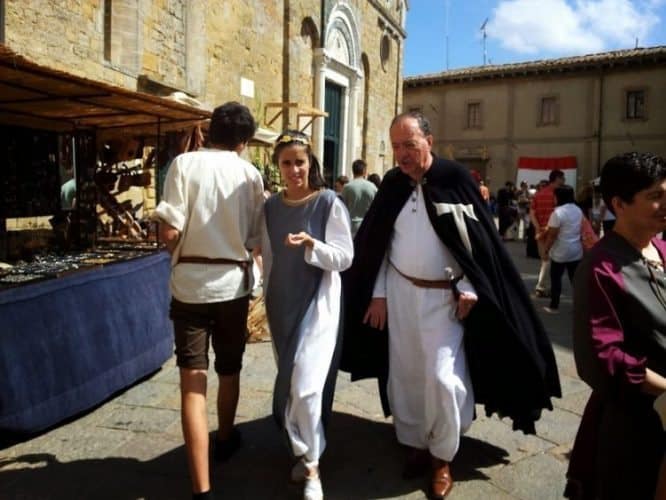
Maybe eggplants were involved or beans, it was hard to say, but hardly mattered because each as we sampled each item in turn it turned out to be so meltingly delicious we hardly cared. The pasta was fresh and al dente, a red wine from the Castello’s own vineyards light and fruity. We sat on the terrace, wrapping ourselves in jumpers as the air cooled, enjoying the view of the church and the tiny central piazza, against a backdrop of lights from the valley beyond.
Discovering the Swimming Pool
The following day we ambled down a dusty path between the olive groves to a chorus of chirruping insects I supposed were cicadas, as we headed for the Castello’s swimming pool. It didn’t disappoint. The pool area, fenced to keep out wild animals, is surrounded by lawns from where you can see the maritime plain rolling out in the distance.
Though it’s not expensive to stay at Castello Quercetto di Ginori, it definitely feels select – there’s no question of having to colonise sunbeds with towels because there simply aren’t that many guests. The pool is tastefully landscaped to give the impression of style and luxury, but there’s a simplicity to everything which makes it comfortable rather than grand. (Castello Ginori di Querceto apartments from 420 Euros per week)
I’d come with my husband and our three children aged 14 to 22, our friend Jacqui joined us with her youngest son, which meant our amalgamated posse of youngsters was big enough to have fun even when they had the pool to themselves.
But a bunch of lively teens were never going to content themselves with a pool, however artfully laid out. The sea beckoned, and with it the puzzling Italian concept of seaside.
Life’s a Beach

From Castello Ginori di Querceto it’s a little over a twenty minute drive to the beach, so we packed towels and picnic and headed for romantic sounding Castiglioncello. Parking the cars proved to be a bit of a challenge, so y the time we hit the sand the kids were hot, bothered and bursting to swim.
As they rushed for the water they barely noticed how eerily regimented the scene confronting us was – dead straight rows of sun-loungers and deck chairs divided by boardwalks. They only registered the heavy security guards when they were actually blocking the way to the water.
Unlike Britain and other countries including most of Spain and Portugal where beaches are common property –- nature’s playground for all to enjoy– in much of Italy they are colonised by hotels and restaurants. The beach isn’t wild and free here at all, it is something which must be dominated, civilized – and above all, owned. Rows of sunbeds are divided into separate zones by chain-link fences, each section ruled by a different establishment and patrolled by its employees.
You can’t just roll up onto the beach, you have to pay. The space you rent may come with wi-fi and other mod cons including hot showers and as it turned out, the use of a kayak, but it certainly doesn’t come free.
Signora in a Lemon Bikini
Once we’d chosen a section, I had to negotiate with a granite-faced signora in a lemon bikini who wanted an extortionate 100 Euros for the seven of us to spend a day at the seaside. I eventually negotiated her down to a four-hour session, hoping she wouldn’t notice quite how many of us there were piling our bags, towels and snorkels between one sunbed and one deckchair, which we took turns on.
Our antics won us a share of both sympathetic smiles and hostile glares from our neighbors, but we eventually won over the lemon bikini, who opened up to me about her halcyon days in the glamorous London borough of Hackney. And that kayak was worth the money.
We tried one more day by the sea at Cecina Maritimo, squeezing ourselves into the narrow, pebbly strip of free ‘public beach’ just next to the road, before giving up on grounds of cost and comfort and decamping for a pizza.
After all, a day at the local water park didn’t cost that much more and you could have loads of fun on the slides without ever being told off. (Acqua Village Cecina Adults 22 Euros per day, children 15 Euros) The beaches, we realised, are not what brings people to Italy.

There were so many other things to do, starting with buying wonderful local produce at the market and at the surprisingly good supermarket. Even the local corner store had something interesting to offer, the shopkeeper was both sweet and patient with our clumsy enquiries. A few enjoyable hours were spent simply sitting in the sun on the shared terrace at Castello, painting, playing backgammon and enjoying the wonderful view.
We spent a day in Florence, paying homage to the great masters of Italian renaissance art at the famous Uffizi Gallery (Adults 21.50 Euros, Students 16 Euros, Under 18 Free) though several of our party, both adults and teens, found the sheer scale of the offer overwhelming.
Michaelangelo’s David
Michaelangelo’s David standing under the rotunda of the Accademia Museum was rather more to our taste, his cool white marble proving far more digestible than the rich diet of oil painting and gold leaf. (Adults 21.5 Euros, Students 16 Euros, Under 18s free.)
Staggering under the weight of so much culture, we repaired to Vivoli’s traditional ice cream parlor – according to my husband, the best in Florence in his long-gone twenty-somethings, and as we discovered, still a quality product. (No cones, just cups from 2 to 10 Euros).
Then we stumbled on something surprising and wonderful – Florence’s vast and beautiful Great Synagogue, and the tiny museum stuffed into its eaves. Arriving with no great expectations, it engaged and absorbed us for a fraction of what we’d spent on great works of art. (Adults 6.5 Euros, concessions 5 Euros).
A taste of Medieval Life in Volterra
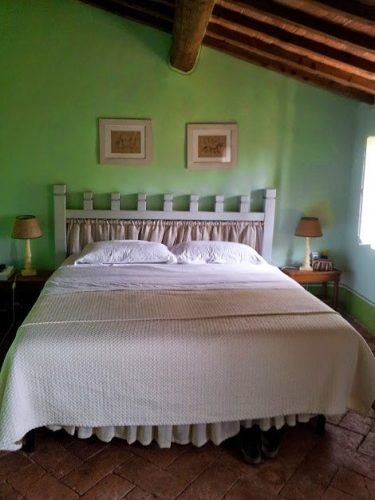
The walled town of Volterra is best known to readers around the world from Stephanie Meyer’s Twilight vampire books, but locally it’s associated far more with the annual medieval festival.
There was a smidgeon of teenage eye-rolling when we explained that the town would be full of people dressed as serfs to re-enact historic times.
It sounded horribly cheesy, it’s true, but the moment we got there all scepticism was wiped away by the gusto and panache with which the thing is executed. (Admission Adults 10 Euros, Teens 6 Euros, Under 10s free).
The whole town and all its residents are utterly consumed by the festival which transforms the place – locals stroll around in period costumes, street theatre productions take place in the piazzas, and the streets are lined by stalls selling authentic produce (though the medieval honey cookies at 2 Euros were NOT recommended by my 14-year-old son).
There were jousting tournaments and dancing troupes – every part of town buzzing with some kind of activity recreated with loving authenticity.
My girls had flowers laced into their hair, and one of the boys had a go at making a pot, but the highlight of the holiday had to be watching my husband being locked in the pillory and ‘tortured’ with feather dusters by a pair of comedians. What wife could resist such a wonderful spectacle?
Castello Ginori di Querceto
56040 Ponteginori – Pisa
Phone/ Fax 0039 0588 37472/ 0039 055 282433
Mob : 0039 335 5405006
Email: Info@castelloginoridiquerceto.it
Locanda del Sole Ristaurante
Via Francesca 9
Loc. Castello di Querceto
56040 Montecatini
Val di Cecina
Tell 0039 0588 37407
Vivoli Ice Cream
Via dell’Isola delle Stinche 7r
Florence
Tel : 055/292334Acqua Village Cecina
Via Tevere 25,
CECINA (LI) – 57023
Ph/Fax: 0586 622539
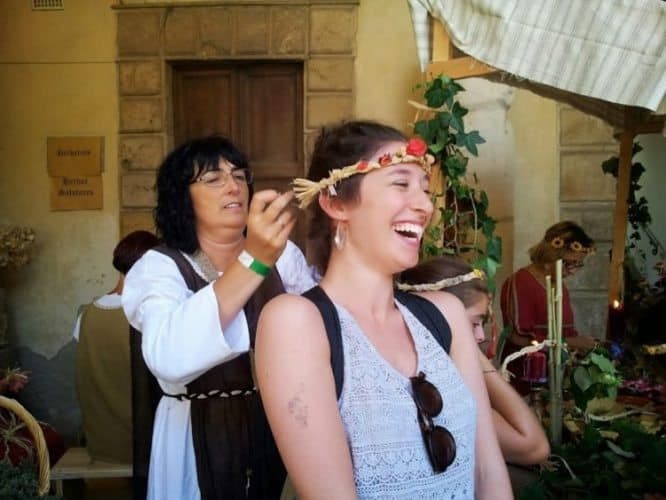
Gaby Koppel is a freelance journalist and television producer whose recent print work has appeared in The Guardian Family, Education and Weekend magazine, Sunday Times Style, The Daily Express and The Independent. She is a Series Producer and Editor of landmark, award-winning series on BBC1 and BBC2.
- These 9 U.S. National Parks Require Reservations in 2024 - April 17, 2024
- Take a Hike in Olympic National Park - April 17, 2024
- The Wild Mississippi: 2340 Miles Across Ten States - April 8, 2024


